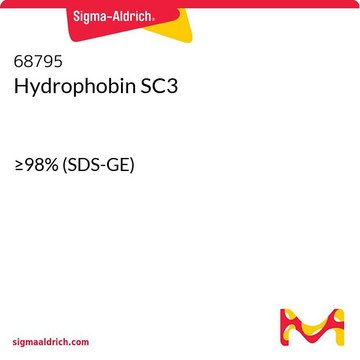Wszystkie zdjęcia(1)
Kluczowe dokumenty
81242
Poly(ethylene glycol)
tested according to Ph. Eur., 4,000
Synonim(y):
Macrogol 4,000, Polyethylene glycol, PEG
Zaloguj sięWyświetlanie cen organizacyjnych i kontraktowych
About This Item
Wzór liniowy:
H(OCH2CH2)nOH
Numer CAS:
Numer MDL:
Kod UNSPSC:
12352104
Identyfikator substancji w PubChem:
NACRES:
NA.21
Polecane produkty
agency
tested according to Ph. Eur.
Poziom jakości
Formularz
solid
masa cząsteczkowa
3500-4500
Zastosowanie
pharmaceutical (small molecule)
ciąg SMILES
C(CO)O
InChI
1S/C2H6O2/c3-1-2-4/h3-4H,1-2H2
Klucz InChI
LYCAIKOWRPUZTN-UHFFFAOYSA-N
Szukasz podobnych produktów? Odwiedź Przewodnik dotyczący porównywania produktów
Powiązane kategorie
Opis ogólny
Poly(ethylene glycol) (PEG) is a non-toxic water-soluble polymer. PEG term is used for the polymer chains with molecular weights below 20 000, while poly(ethylene oxide) (PEO) refers to the higher molecular weight polymers. PEG has various biomedical applications. It forms complexes with α-cyclodextrins. Engineering of PEG hydrogel particles by mesoporous silica (MS) templating method has been reported.
Zastosowanie
Poly(ethylene glycol) may be used in the following studies:
- For the modification of proteins to form the conjugates having increased circulating life and reduced immunogenicity and antigenicity.
- Preparation of hydrogels useful for the diffusion controlled delivery of proteins.
- Preparation of poly(ethylene glycol) dimethacrylate (PEGDM).
Ta strona może zawierać tekst przetłumaczony maszynowo.
Kod klasy składowania
11 - Combustible Solids
Klasa zagrożenia wodnego (WGK)
WGK 1
Temperatura zapłonu (°F)
Not applicable
Temperatura zapłonu (°C)
Not applicable
Środki ochrony indywidualnej
Eyeshields, Gloves, type N95 (US)
Wybierz jedną z najnowszych wersji:
Masz już ten produkt?
Dokumenty związane z niedawno zakupionymi produktami zostały zamieszczone w Bibliotece dokumentów.
Klienci oglądali również te produkty
The clinical efficacy of poly (ethylene glycol)-modified proteins.
Fuertges F and Abuchowski A.
Journal of Controlled Release : Official Journal of the Controlled Release Society, 11(1), 139-148 (1990)
N A Peppas et al.
Journal of controlled release : official journal of the Controlled Release Society, 62(1-2), 81-87 (1999-10-16)
The use of hydrogels as carriers for protein delivery has been a subject of significant recent research. In our recent work, we have shown that diffusion controlled delivery of proteins from hydrogels containing poly(ethylene glycol) (PEG) can be possible and
Stephanie J Bryant et al.
Annals of biomedical engineering, 32(3), 407-417 (2004-04-21)
In approaches to tissue engineer articular cartilage, an important consideration for in situ forming cell carriers is the impact of mechanical loading on the cell composite structure and function. Photopolymerized hydrogel scaffolds based on poly(ethylene glycol) (PEG) may be synthesized
Complex formation between poly (ethylene glycol) and α-cyclodextrin.
Harada A and Kamachi M.
Macromolecules, 23(10), 2821-2823 (1990)
Idalis Villanueva et al.
Acta biomaterialia, 5(8), 2832-2846 (2009-06-11)
The pericellular matrix (PCM) surrounding chondrocytes is thought to play an important role in transmitting biochemical and biomechanical signals to the cells, which regulates many cellular functions including tissue homeostasis. To better understand chondrocytes interactions with their PCM, three-dimensional poly(ethylene
Nasz zespół naukowców ma doświadczenie we wszystkich obszarach badań, w tym w naukach przyrodniczych, materiałoznawstwie, syntezie chemicznej, chromatografii, analityce i wielu innych dziedzinach.
Skontaktuj się z zespołem ds. pomocy technicznej


